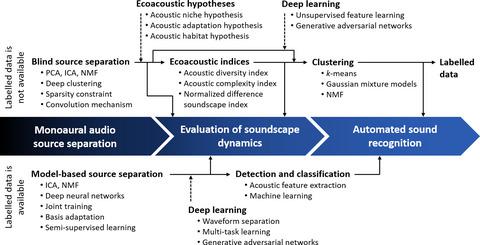当前位置:
X-MOL 学术
›
Remote Sens. Ecol. Conserv.
›
论文详情
Our official English website, www.x-mol.net, welcomes your
feedback! (Note: you will need to create a separate account there.)
Source separation in ecoacoustics: a roadmap towards versatile soundscape information retrieval
Remote Sensing in Ecology and Conservation ( IF 3.9 ) Pub Date : 2019-12-16 , DOI: 10.1002/rse2.141 Tzu‐Hao Lin, Yu Tsao
Remote Sensing in Ecology and Conservation ( IF 3.9 ) Pub Date : 2019-12-16 , DOI: 10.1002/rse2.141 Tzu‐Hao Lin, Yu Tsao

|
A comprehensive assessment of ecosystem dynamics requires the monitoring of biological, physical and social changes. Changes that cannot be observed visually may be trackable acoustically through soundscape analysis. Soundscapes vary greatly depending on geophysical events, biodiversity and human activities. However, retrieving source‐specific information from geophony, biophony and anthropophony remains a challenging task, due to interference by simultaneous sound sources. Audio source separation is a technique that aims to recover individual sound sources when only mixtures are accessible. Here, we review techniques of monoaural audio source separation with the fundamental theories and assumptions behind them. Depending on the availability of prior information about the source signals, the task can be approached as a blind source separation or a model‐based source separation. Most blind source separation techniques depend on assumptions about the behaviour of the source signals, and their performance may deteriorate when the assumptions fail. Model‐based techniques generally do not require specific assumptions, and the models are directly learned from labelled data. With the recent advances of deep learning, the model‐based techniques can yield state‐of‐the‐art separation performance, accordingly facilitate content‐based audio information retrieval. Source separation techniques have been adopted in several ecoacoustic applications to evaluate the contributions from biodiversity and anthropogenic disturbance to soundscape dynamics. They can also be employed as nonlinear filters to improve the recognition of bioacoustic signals. To effectively retrieve ecological information from soundscapes, source separation is a crucial tool. We believe that the future integrations of ecological hypotheses and deep learning can realize a high‐performance source separation for ecoacoustics, and accordingly improve soundscape‐based ecosystem monitoring. Therefore, we outline a roadmap for applying source separation to assist in soundscape information retrieval and hope to promote cross‐disciplinary collaboration.
中文翻译:

生态声学中的源分离:通向多功能音景信息检索的路线图
全面评估生态系统动态需要监测生物,物理和社会变化。通过声景分析,可以在视觉上跟踪到视觉上无法观察到的变化。声景的变化取决于地球物理事件,生物多样性和人类活动。但是,由于同步声源的干扰,从地音,生物音和人类学中检索特定于源的信息仍然是一项艰巨的任务。音频源分离是一种旨在仅可访问混合物时恢复单个声音源的技术。在这里,我们回顾了单声道音频源分离的技术及其背后的基本理论和假设。根据有关源信号的现有信息的可用性,可以将任务作为盲源分离或基于模型的源分离来处理。大多数盲源分离技术取决于有关源信号行为的假设,当这些假设失败时,它们的性能可能会降低。基于模型的技术通常不需要特定的假设,并且可以直接从标记的数据中学习模型。随着深度学习的最新发展,基于模型的技术可以产生最先进的分离性能,从而促进基于内容的音频信息检索。在几种生态声学应用中已经采用了源分离技术,以评估生物多样性和人为干扰对声景动力学的贡献。它们也可以用作非线性滤波器,以改善对生物声信号的识别。为了有效地从声景中检索生态信息,源分离是至关重要的工具。我们认为,生态假说和深度学习的未来集成可以实现高性能的生态声学源分离,从而改善基于声景的生态系统监控。因此,我们概述了应用源分离来协助音景信息检索的路线图,并希望促进跨学科的合作。
更新日期:2019-12-16
中文翻译:

生态声学中的源分离:通向多功能音景信息检索的路线图
全面评估生态系统动态需要监测生物,物理和社会变化。通过声景分析,可以在视觉上跟踪到视觉上无法观察到的变化。声景的变化取决于地球物理事件,生物多样性和人类活动。但是,由于同步声源的干扰,从地音,生物音和人类学中检索特定于源的信息仍然是一项艰巨的任务。音频源分离是一种旨在仅可访问混合物时恢复单个声音源的技术。在这里,我们回顾了单声道音频源分离的技术及其背后的基本理论和假设。根据有关源信号的现有信息的可用性,可以将任务作为盲源分离或基于模型的源分离来处理。大多数盲源分离技术取决于有关源信号行为的假设,当这些假设失败时,它们的性能可能会降低。基于模型的技术通常不需要特定的假设,并且可以直接从标记的数据中学习模型。随着深度学习的最新发展,基于模型的技术可以产生最先进的分离性能,从而促进基于内容的音频信息检索。在几种生态声学应用中已经采用了源分离技术,以评估生物多样性和人为干扰对声景动力学的贡献。它们也可以用作非线性滤波器,以改善对生物声信号的识别。为了有效地从声景中检索生态信息,源分离是至关重要的工具。我们认为,生态假说和深度学习的未来集成可以实现高性能的生态声学源分离,从而改善基于声景的生态系统监控。因此,我们概述了应用源分离来协助音景信息检索的路线图,并希望促进跨学科的合作。











































 京公网安备 11010802027423号
京公网安备 11010802027423号